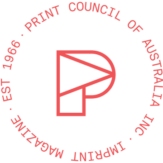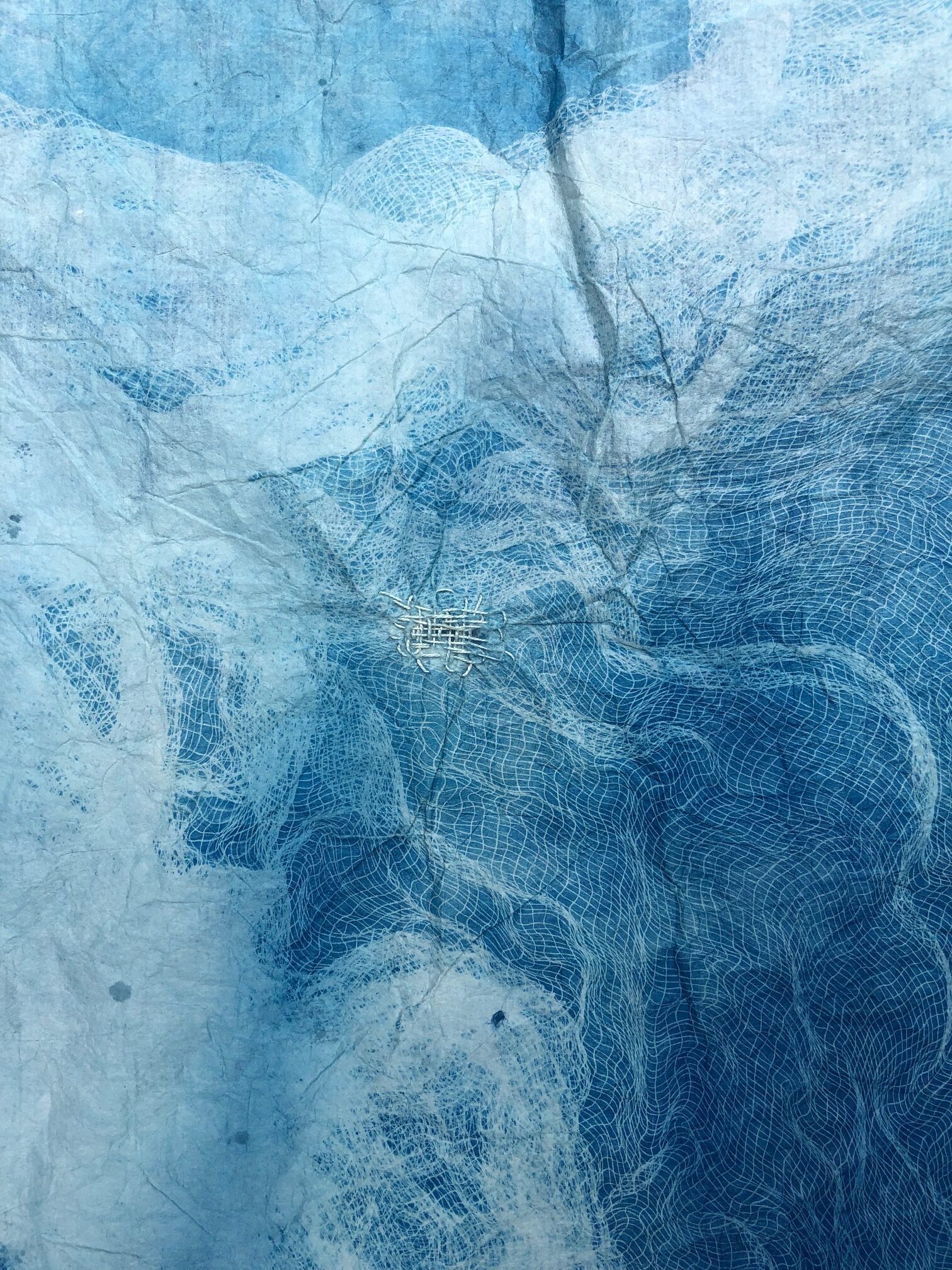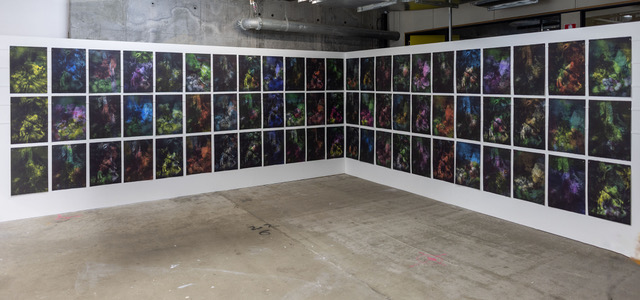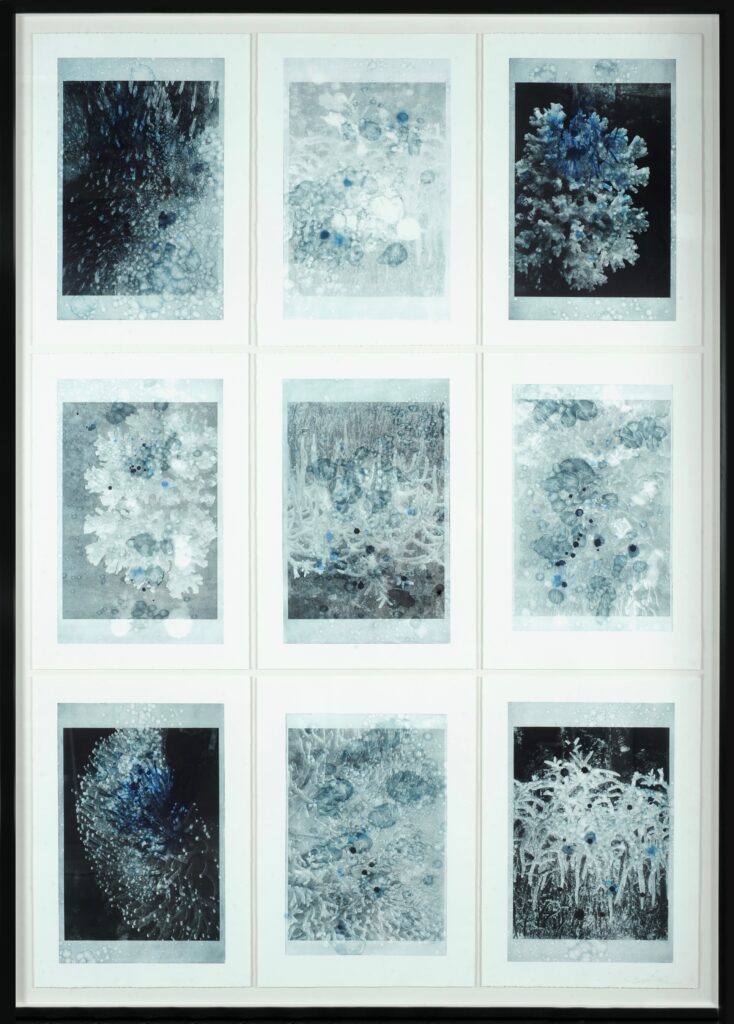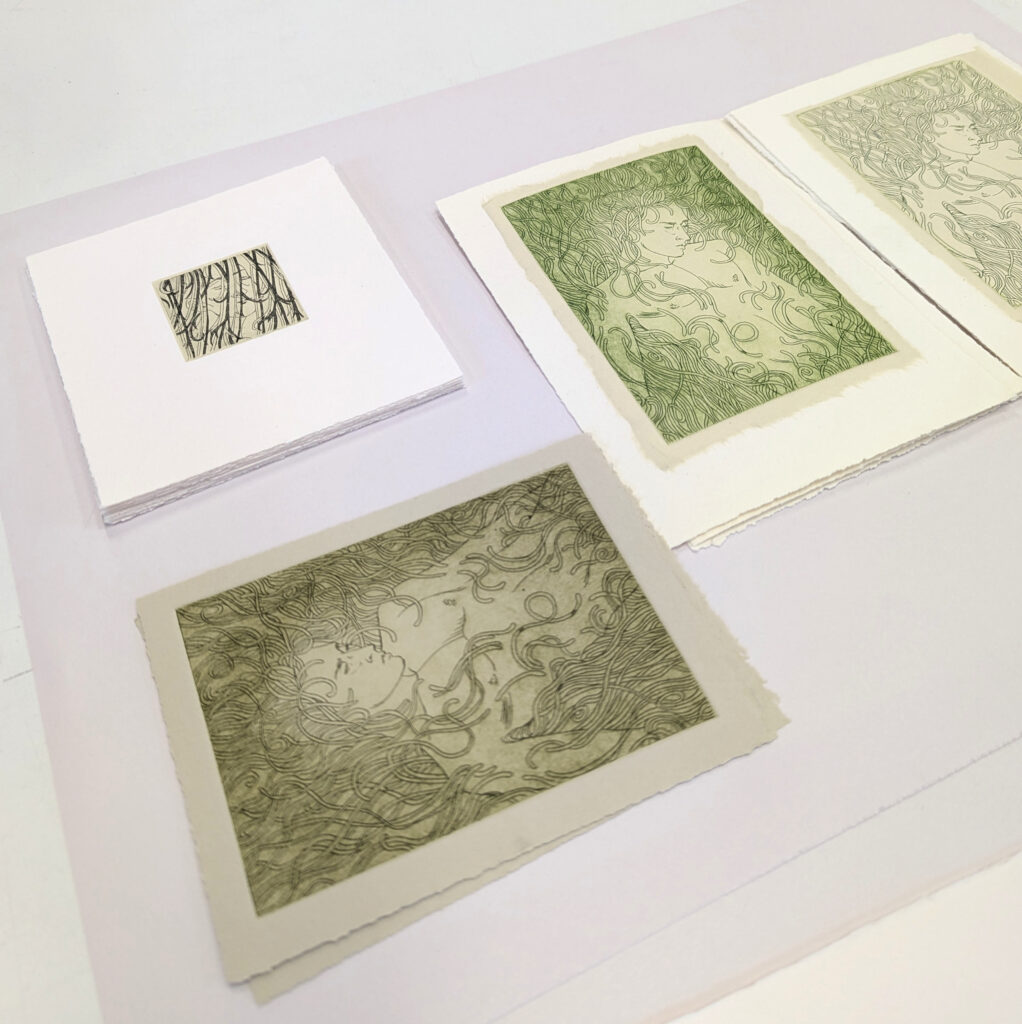Top:
Nicole O’Loughlin, Drifting (detail), 2023, cyanotype print on Kozo with cotton and muslin, 73 x 130cm, unique state.
Below:
Nicole O’Loughlin, Within and Beyond (blue and white) (detail), 2022, woven white ground etchings, 24 x 24 cm.
Tim Coad, Drawn Over, drypoint etching on Hanhemühle paper, 106 x 79cm, unique state.
Tim Coad, Rokeby Hills no.2, drypoint etching on Hanhemühle paper, 106 x 79cm, unique state.
Mindy Doré, Marble Run VIII, 2023, pochoir and silver pigment linocut on BFK Rives paper, 76cm x 56cm, unique state.
Mindy Doré, River of Leaves, 2021, monoprint and silver pigment linocut on BFK Rives paper, 56cm x 38 cm, unique state.
All works reproduced with permission of the artists.
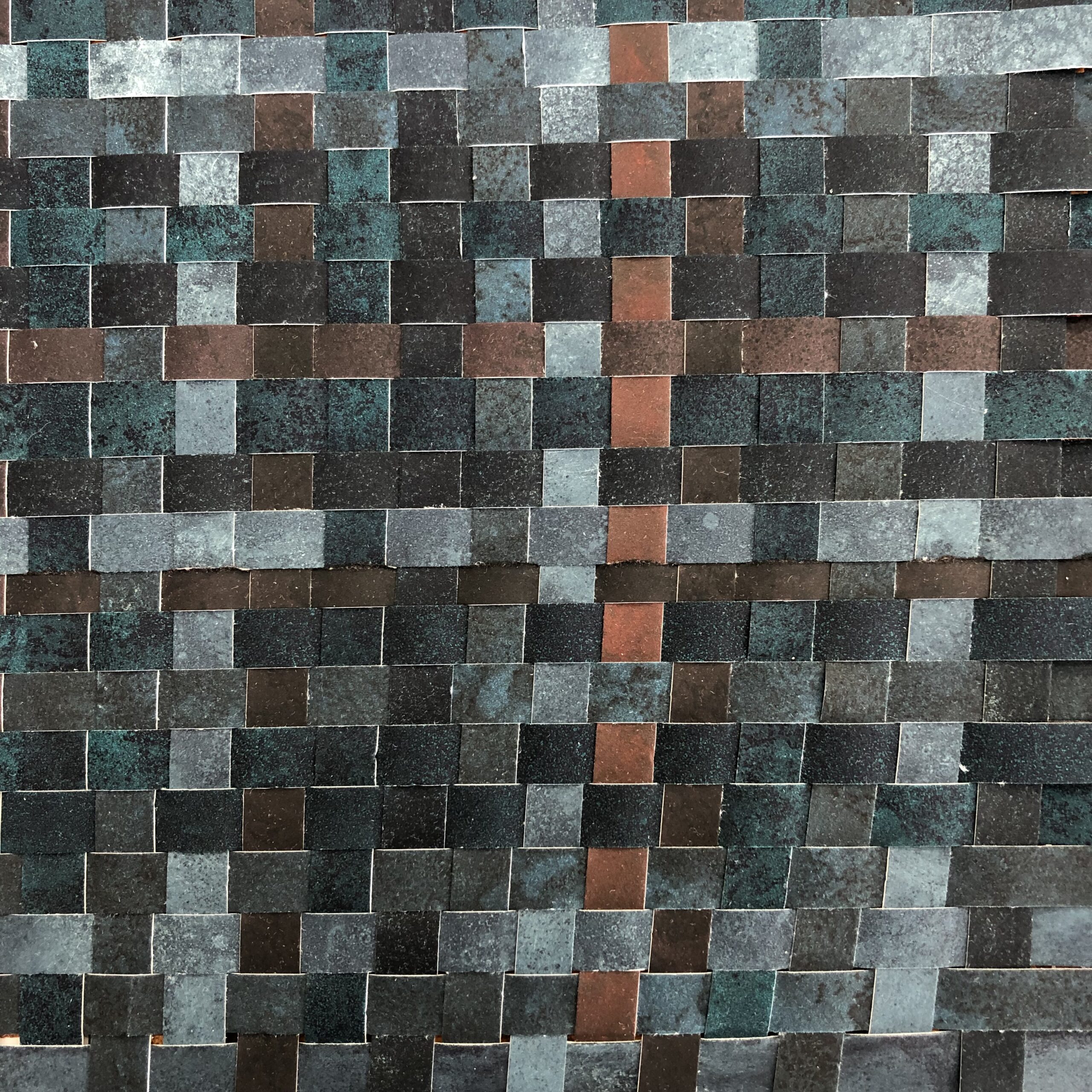
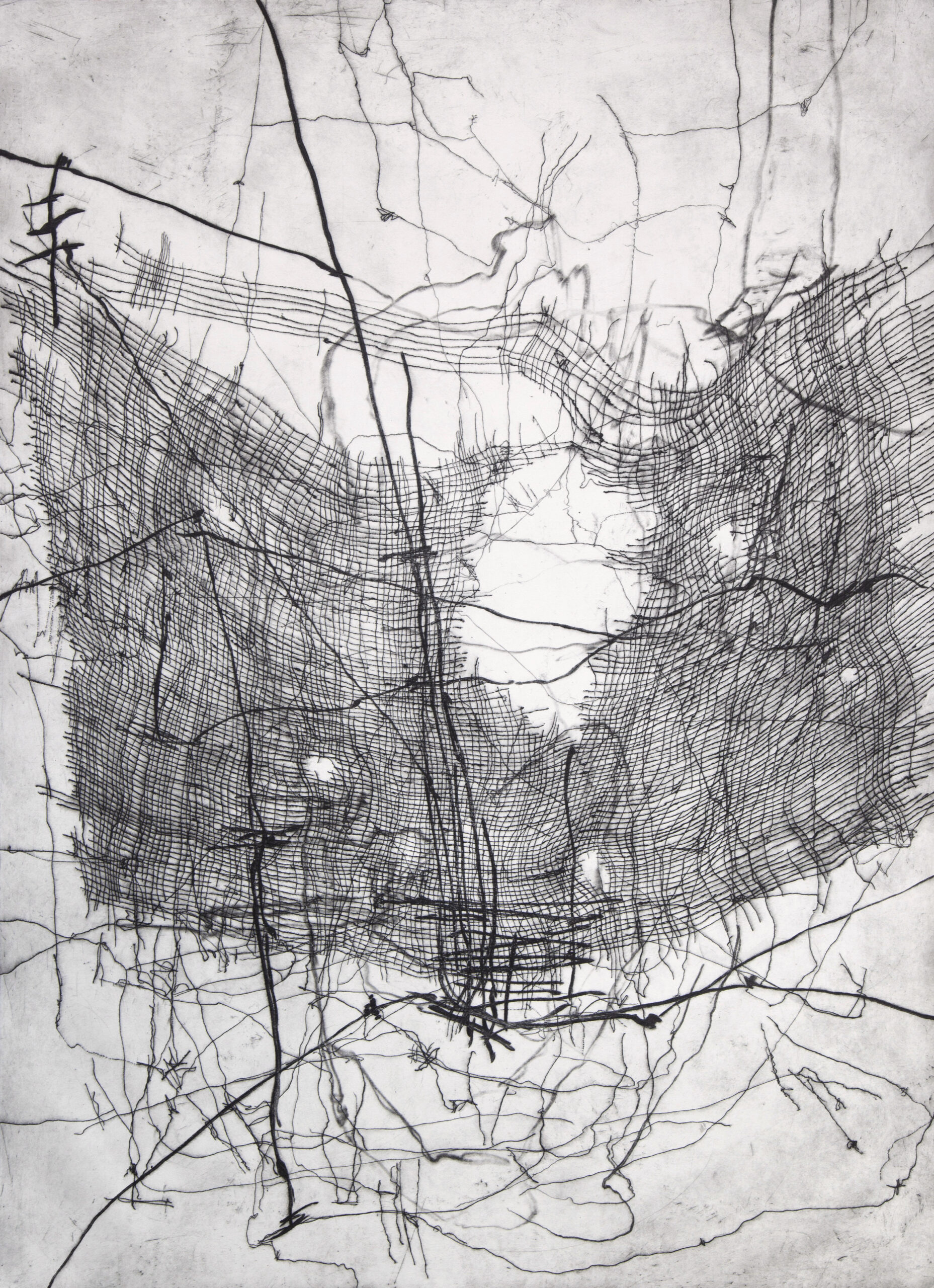
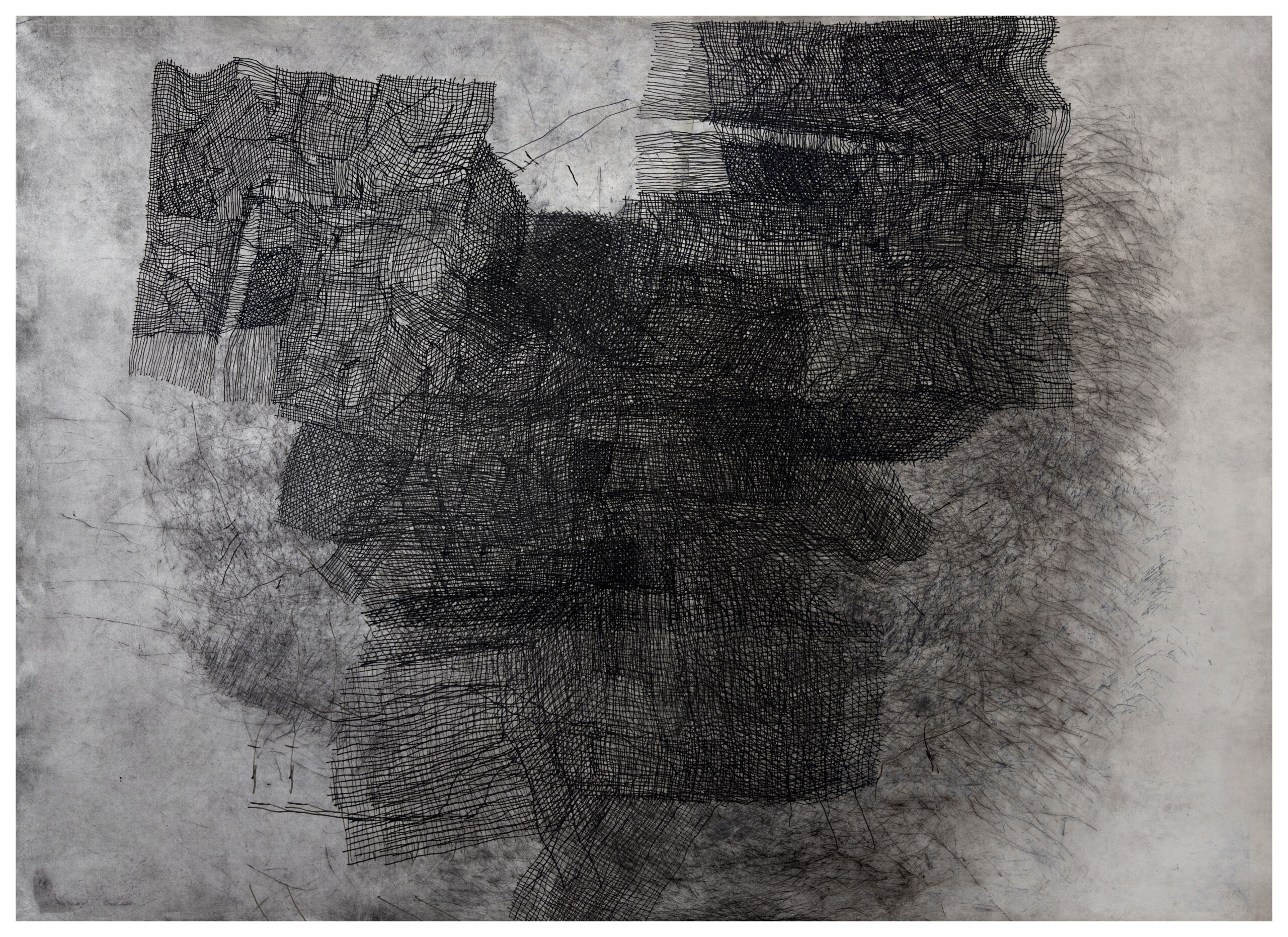


At a distance, and in relation
The nowhereprint collective consists of seventeen artists based in Tasmania/lutruwita. The group evolved following the success of its first exhibition from a distance at May Space Online in May 2021. Initiated by artists Melissa Smith and Helen Mueller in 2020 during COVID-19 restrictions, they aimed to connect Tasmanian printmakers at different stages of practice, provide mentorship for emerging artists, and showcase the diversity of print practice to new audiences. Drawing together artists working with notions of place, Smith and Mueller wanted to explore the experience of living and making in this unique island location at this moment. Since the first show, the group has exhibited at Press West as part of the Unconformity Festival in Queenstown, Tasmania (2021); Handmark Gallery in Hobart (2022); Poimena Gallery in Launceston (2022); Impact 12 International Printmaking Conference in Bristol (2022), UK; Megalo Print Studio in Canberra (2023) and Derwent Valley Arts in New Norfolk, Tasmania (2023).
From a distance at May Space Online focused on notions of place at a time when many were forced to be socially and physically distanced. Being both separated from and yet finding new ways of being in relation to others was a common experience during the first years of the pandemic. It was an understanding many in the group could relate through living on an island. When Melissa Smith first contacted me in late 2020, I was undertaking a residency at Arthur River in the remote north-west coast of Tasmania. This is a fertile intertidal zone where the tannin-tinted river meets with wild salty swells of the Southern Ocean. I was acutely aware that while the virus moved uncontrollably around the world, with fatalities rising and people’s movements being restricted in desperate attempts to quell the spread, here I was sitting and walking with relative freedom. I began to contemplate how the geographical distance was protective, and at the same time how I was connecting with others through devices—socialising and teaching through chains of digital communication—with an intensity I hadn’t experienced.
Islands present one with an opportunity to examine what it means to coexist locally and globally; to be both autonomous and in-relation; particular and part of a constellation of place relationships. Maltese and Canadian social scientist Godfrey Baldacchino writes ‘An Island is a World; yet an Island engages the World’[i]. When engaging individuals in the print group about their sense of ‘islandness’ two key ideas emerge. The first is a sense of being in-between—of simultaneously being both here and there. The second is an intimacy and solace found in the proximity one has to the land, sea and sky.
Islands as sites of curiosity, imagination and poetic possibility have been well explored in the visual arts, film, and literature. In recent years there has been a conceptual shift from island scholarship and thinking towards the archipelago. The archipelago presents models for thinking and practice that shift dominant Western and protectionist ideas of ‘singularity’ and ‘isolation’, towards broader understandings of islands as inter-related constellations.[ii] The liquid space between islands is an active space providing passageways and linkages between places and people. This is something that resonates with many in the group who are exploring the particularities of place as well as how that place speaks and connects to broader networks, narratives, ideas, and politics, and how their personal identities are shaped by the multiplicity of places in which they belong, connect, and relate.
Where we are
Tasmania/lutruwita is part of an archipelago of more than 300 islands positioned to the south of mainland Australia, connected or separated (depending how you conceptualise this watery space) by Bass Strait. The island has been inhabited for millennia, cultivated and cared for by the Palawa/Pakana peoples. The land bridge between islands was submerged about 12,000 years ago by rising seas, a detachment that has enabled the evolution of many species that developed and adapted to the unique island conditions. The climate is influenced by the force and convergence of the Southern Ocean, Tasman Sea and Roaring Forties. Its ancient landscape has a complex geology, with a large exposure of Jurassic dolerite that underpins and shapes its distinct ecology.
Tasmania/lutruwita has been exploited and adapted to feed the colonial hunger for timber, minerals, and agriculture since the early 1800s. Its communities encountered some of the most brutal frontier conflicts, a history we the inhabitants are slowly coming to terms with aided by a rising First Nations voice requesting truth-telling. These unique qualities of place are what bind us as a group of printmakers. Our diversity of conceptual and material responses reflects these complex cultural and ecological conditions in which we live and make, shaping personal and collective narratives.
Who we are
Among the seventeen artists in the group is a spectrum of mediums and printmaking approaches, from traditional techniques to digital imaging and 3D fabrication technologies. The collective creates exhibitions through an exchange, each artist sending and assembling respective practices to form new constellations of ideas, themes and material responses. We are also informed by the diversity of spaces in which we exhibit, some lending to more experimental practice and others more traditional modes of presentation. Nicole O’Loughlin, Tim Coad and Mindy Doré are three artists in the group who demonstrate some of the diversity of print practice and common conceptual threads.
Nicole O’Loughlin is an artist based in the Derwent Valley, on the lands of the Big River Nation. Her sensitive material investigations are informed directly from the elemental qualities of place including light, water, texture, and colour. She uses her knowledge of textiles and printmaking to embed, imprint, weave, darn and stitch a relationship with place. This process is a direct response to a sense of flux, intangibility and complexity felt living in Tasmania/lutruwita. In many ways she embodies this archipelagic thinking with works such as Drifting (2023) and Within and Beyond I & II (2022) whereby she considers her own position as a settler descendent and a woman moving and making with ebb and flow of the tide. These works could be seen as an attempt to consider what it is to be unanchored and resistant of a dominant settler desire for fixity.
Tim Coad is an artist living between Hobart/nipaluna and Ngaanyatjarra, Pitjantjatjara, Yankunytjatjara land. Coad uses a range of strategies including intaglio printmaking, drawing and photography to record and trace the human impact in his local environments. Describing these sites as ‘disputed landscapes’, Coad is interested in how to respond to places that have been overwritten, forgotten, and constructed. These sites of ‘collision’ present tensions which Coad responds to through mark-making. The slippery and abrasive qualities of drypoint printmaking is one approach that has enabled Coad to attend to this experience. In Drawn Over (2023) wiry nets (detritus) float as a visceral and unsettled embodiment of site.
Mindy Doré is an artist living and making between the presence of Mt Wellington/kunanyi and River Derwent/timtumili minanya in Hobart/nipaluna. Using the monotype process she draws from the elemental and atmospheric qualities of place and the way this informs her inner state of being, or what she calls her ‘inner home’. Colour, form and space are used to compose single-state abstract registers. They are both poetic and playful. Doré uses a process that is slow and rhythmic. This is intended as both a settling practice and one that mimics the cycles of the environment around her.
O’Loughlin, Coad and Doré respond directly to the ecological and cultural conditions of our island. Each feels a deep affinity with the place and a sense of it holding them and their practice. When asked directly about what the island provides Coad replied: ‘When I breathe the air I feel a briskly welcomed home, the land pulls me closer with every breath. When I am away from home, I feel a looming absence and disconnection to my identity.’[iii] The printmaking process enables ways for artists in the print collective to trace, record and interpret their sensory and narrative responses to the complex and shifting nature of the island. Each gesture appears to embody a sense of tenderness expressed in the marks, substrates and surfaces which attempt to caress the state of being in-between: attuned, flexible and responsive to what is both close and distant.
—
Latitude, an exhibition by nowhereprint print collective, is at the Print Council of Australia Gallery, Studio 2 Guild, 152 Sturt Street, Southbank, Melbourne, 8-25 October. Opening reception: Thursday 10 October, 5–7pm.
Exhibiting artists: Antonia Aitken, Tim Coad, Tony Curran, Mindy Doré, Jan Hogan, Olivia Moroney, Helen Mueller, Hope Smith, Melissa Smith, Emma Magnusson-Reid and Grace Gladdish.
[i] Godfrey, Baldacchino, ‘Editorial: Islands — Objects of Representation’, Geografiska Annaler: Series B, Human Geography. 87. 247 – 251, 2005, 284.
[ii] Stratford, Elaine; Baldacchino, G; McMahon, E; Farbotko, C; Harwood, A (2011). Envisioning the Archipelago. University Of Tasmania. Journal contribution. https://hdl.handle.net/102.100.100/583008, Accessed 11 September 2023.
[iii] Coad, Tim, email communication with Antonia Aitken, 4 July 2023.
—
Join the PCA and become a member. You’ll get the fine-art quarterly print magazine Imprint, free promotion of your exhibitions, discounts on art materials and a range of other exclusive benefits.
